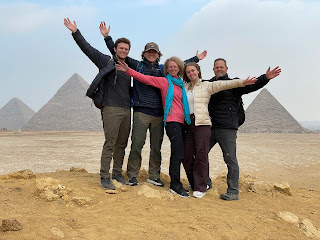The Great Pyramid of Giza - That’s Dope - Day 12
No trip to Egypt is complete without a stop at the Giza Pyramids, and I'm glad we've saved the grand prize for last. Of the Seven Wonders of the Ancient World, only the Pyramid of Giza still remains standing.
It is hard to beat the grandeur of seeing the Great Pyramid, the last of the Seven Wonders of the Ancient World. "That's dope," said our guide, when he saw the picture from our balcony.
The pyramids take ancient to a whole new level. Built over 4500 years ago, they are over twice as old as any of those impressive structures in Rome and Greece!
Technically there's just one Great Pyramid and that's the oldest and largest pyramid at Giza known as the Pyramid of Khufu. Khufu ruled over Egypt during the Fourth Dynasty (2500 BC).
For more than 4,000 years, the Great Pyramid was the tallest building in the world.
However, the Great Pyramid doesn't look like it is the largest one. The second oldest and second largest is the Pyramid of Khafre (Khufu's son). Built on higher terrain, it actually looks taller than the Great Pyramid even though it is 7 feet shorter.
The third primary pyramid you'll see at Giza is the Pyramid of Menkaure. The other 6 small pyramids belong to queens – bringing the total Giza pyramid count to 9. (Note – there are over 100 pyramids throughout Egypt.)
Our guide (Mohamed Osama) said that a week ago the pyramid complex was so crowded you couldn't walk freely around. The line to get inside the pyramid was over a hour.
Initially I had ruled out entering the Great Pyramid (extra fee) because I thought we would have already seen our fair share of tombs. We changed our minds when a tourist we met in Jordan highly recommended it. She warned us not to go if we were claustrophobic.
The Great Pyramid has over 2.3 million stones and dates back to 2500BC. It is illegal to climb on any pyramid, except to get into its entrance.
I assumed the tomb was underneath the pyramid but it was actually at the very top. The shaft to get there was extremely tight and narrow. Because of the line of people trying to crawl both directions through the small space, I literally felt panic starting to set in and almost turned around - but squelched the urge.
A wee bit small, don't you think!!
Going inside the Great Pyramid was an adventure that we all enjoyed. It is very warm inside, like a sauna. You climb up 130m to the burial chamber. The top of the pyramid is 137m high.
After all that effort and bravery, the fricken tomb was empty - no mummy or treasures to be found! Kate's commentary: "I didn't cry! That was cool. I don't know what I was expecting but I was expecting more."
I would highly recommend going all the way to the Panoramic Viewpoint in the pyramid complex. It offers the best view of the three main pyramids. From there you can catch a camel or horse ride for more superb views.
The view from the Panoramic Viewpoint clearly makes the Pyramid of Khafre appear tallest.
For thousands of years, the Sphinx has guarded the pyramids and looked out towards the Nile (but today he stares at Pizza Hut).
After leaving the Pyramid necropolis, we were supposed to be visiting the nearby Grand Egyptian Museum, known as the GEM for short - but they just can't seem to get it finished. After over 20 years of construction, they had planned to open it almost two years ago - and definitely by 2022. When it is finally completed (assumably in this century), the Grand Egyptian Museum will be one of the largest, most modern, and most renowned museums in the entire world. The exhibit space constitutes the equivalent of four football fields and already includes the enormous Solar Boat of Khufu, a colossal statue of King Ramses II, and many artifacts already removed from the Old Egyptian Museum.
Instead of the GEM, we visited the Old Egyptian Museum in downtown Cairo. It used to feel like a crammed, unorganized warehouse. But now that the artifacts are being moved to the GEM, it feels like a spacious museum.
The highlight of a visit to the Old Egyptian Museum is the exhibit of a King who doesn't need an introduction. No entombed Egyptian pharaoh has had the stunning and star-studded afterlife as King Tut. His golden death mask was breathtakingly crafted over 3,300 years ago and is probably the most recognizable artifact we have from antiquity. Contributing largely to his fame is likely the traveling King Tut exhibit - which is how I saw it in Los Angeles and became obsessed as a kid.
No photography is allowed in the King Tut exhibit.
Our very last activity before we fly out tomorrow was walking down Al-Muizz Li-Din Allah Al-Fatima Street. One of the oldest streets in Cairo, it's a 1 km long pedestrian street.
According to the UN, Al-Muizz Li-Din Allah Al-Fatima Street has the greatest concentration of medieval architectural treasures in the Islamic world.
Muizz Street today is a mix of medieval mosques and buildings alongside modern vendors and shops in an Old Cairo neighborhood, and the street is adjacent to the famous bazaar Khan el Khalili. The street gets pretty chaotic with all the different shops and vendors, so just don't expect a calm stroll and you'll be fine.
One of the many mosques along Muizz Street











Comments
Post a Comment